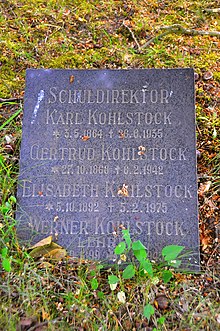Karl Kohlstock
Karl Kohlstock (born May 3, 1864 in Gotha ; † June 26, 1935 there ) was a school director , teacher and local researcher .
Karl Kohlstock was born as the son of the master turner Theodor Kohlstock. In 1881, after attending secondary school, he attended the "Gotha seminar" to become a teacher. In 1884 he had passed the exam and was employed as a teacher at the "Vorstadtschule am Hohe Sand" in Gotha and also taught at several other institutions in Gotha. He also passed his director and secondary school teacher examination in 1896 at the Gotha seminar and was then appointed to Zella to work as director for several years before returning to Gotha in 1904.
Here he was appointed director of the Reyherschule in Gotha from among 63 applicants , where he worked until his retirement in 1929. As a friend of the youth, he enjoyed a high reputation among his students because he sacrificed time, effort and money in order to open up the beauties of his homeland to them.
In addition to his teaching profession, Kohlstock has rendered valuable services to the general public as a successful local researcher. Special mention should be made of his services to the establishment and construction of the local history museum at Friedenstein Castle . The 30 hiking booklets "Discovery trips in the homeland" published by him still offer every reader interested in local history a wealth of local knowledge in a concentrated and understandable form. He was also a member of numerous associations and an active fighter against alcoholism. One of his educational goals was to educate young people who abstained from alcohol. In 1905 the previously founded health food company opened a restaurant in Haus Brühl 19, which - true to Kohlstock's motto - only served non-alcoholic drinks. The "Neudeutsche Erholungsheim" was initially located in this house until Kohlstock moved with him to the restaurant at Schwabhäuser Strasse 24.
A Gothaer Straße in the east of the city bears his name in recognition of his homely work. His grave with that of his wife Gertrud (1868–1942) and his two children is in the main cemetery in Gotha .
Web links
- Karl Kohlstock on the website of the city of Gotha
| personal data | |
|---|---|
| SURNAME | Kohlstock, Karl |
| BRIEF DESCRIPTION | German school director and local researcher |
| DATE OF BIRTH | May 3, 1864 |
| PLACE OF BIRTH | Gotha , Thuringia , Germany |
| DATE OF DEATH | June 26, 1935 |
| Place of death | Gotha |
